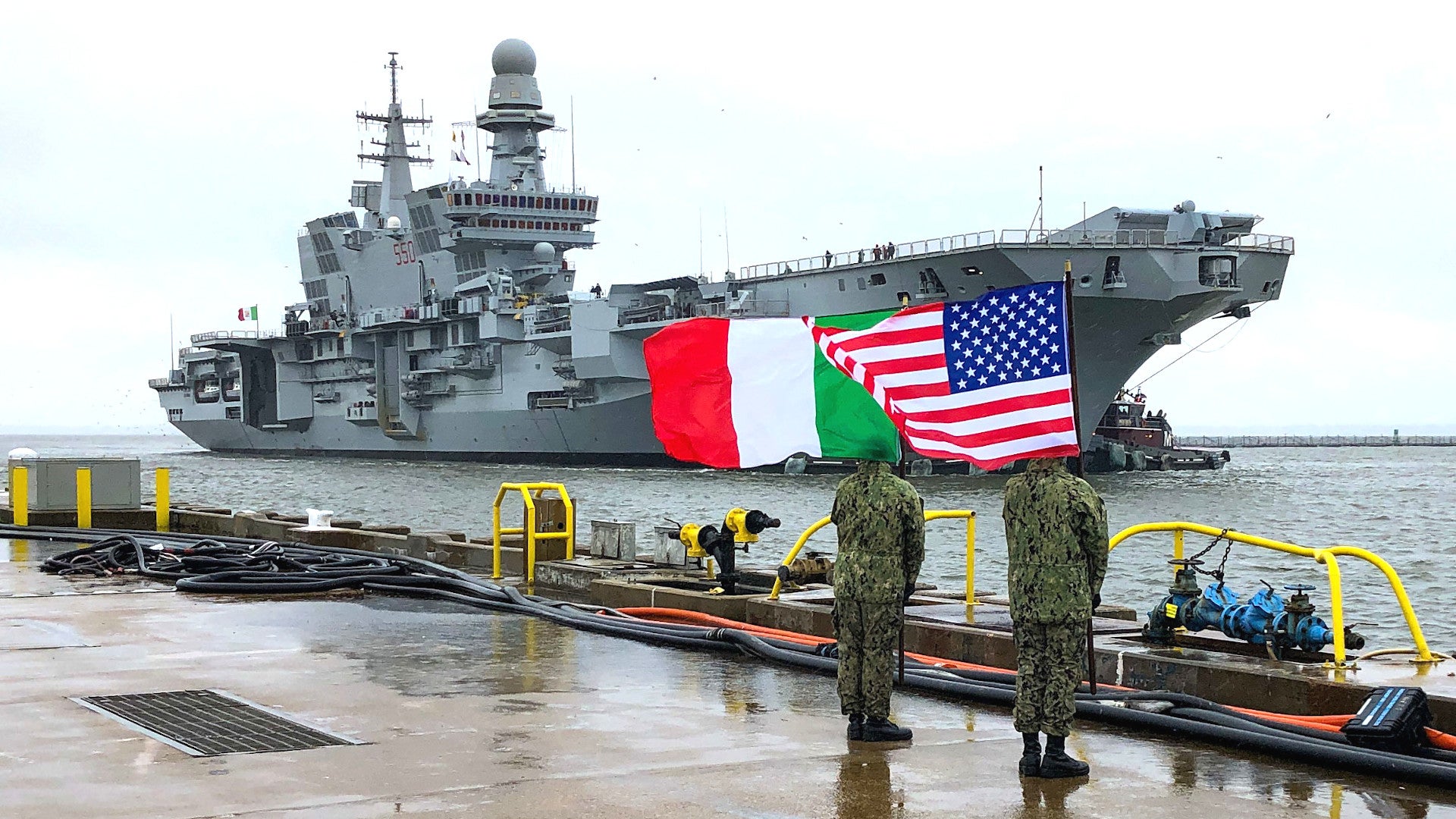Following its Atlantic crossing, the aircraft carrier Cavour, the flagship of the Italian Navy, will conduct its first trials with the F-35B Lightning II stealth fighter. Italy will become the third nation to begin flying the fifth-generation aircraft from an aircraft carrier.
The Cavour entered the Chesapeake Bay on February 13 and docked at Norfolk, Virginia, the homeport of the U.S. Navy’s 2nd Fleet. Trials of the short takeoff and vertical landing (STOVL) F-35B from the warship’s deck are due to begin shortly in close cooperation with the U.S. Navy and Marine Corps. After demonstrating safe launch and recovery of the jets, the end result should be the declaration that the F-35B is “ready for operations” aboard the Cavour. Eventually, it will begin flight deck workups with Itay’s domestically-based F-35Bs.
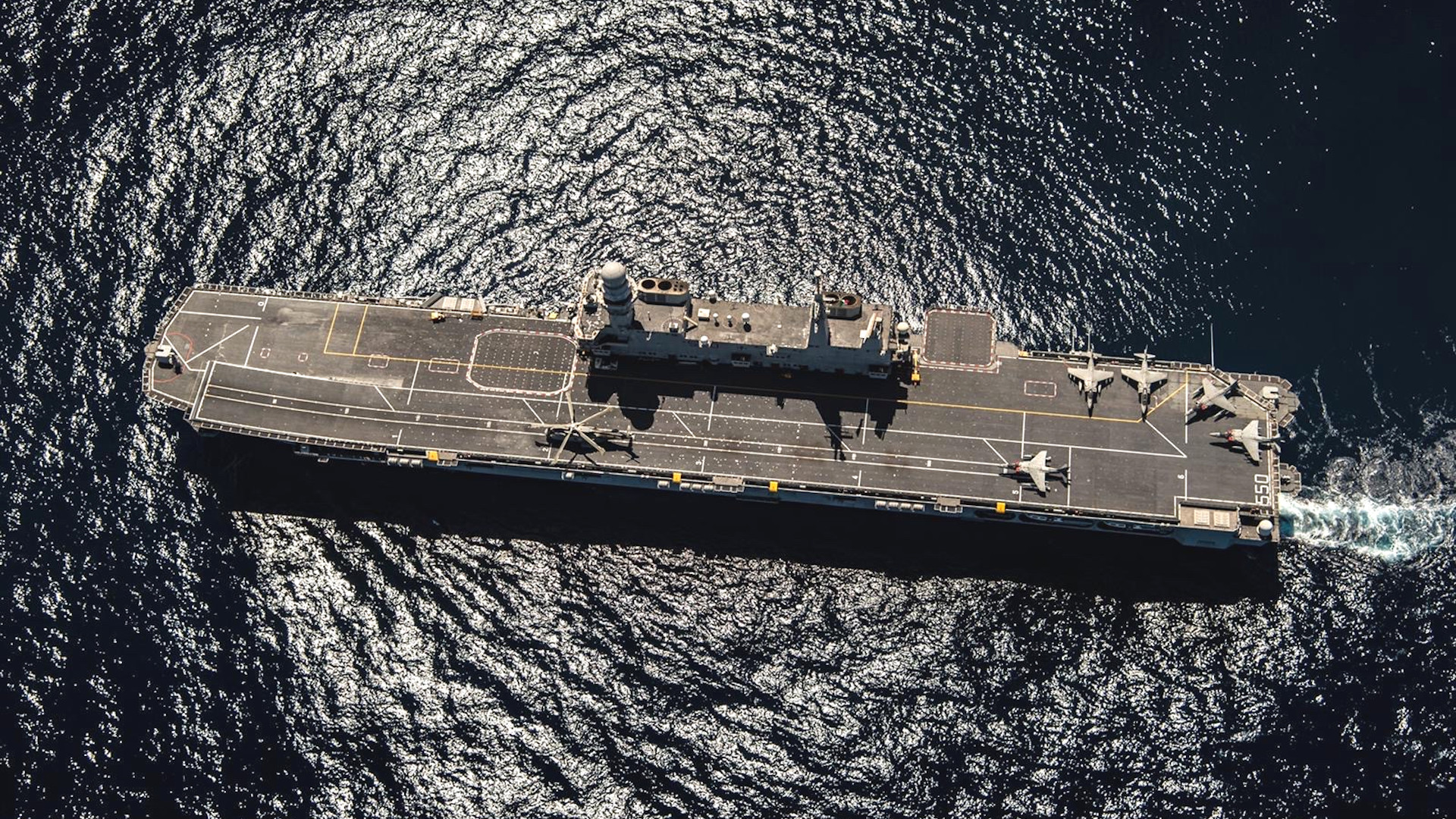
Cavour’s trials with the Joint Strike Fighters are set to similar to those that the British Royal Navy’s aircraft carrier HMS Queen Elizabeth conducted in 2018. The carrier will sail in the Western Atlantic, where it will be joined by U.S. Marine Corps F-35Bs from the Integrated Test Force (ITF) based at Naval Air Station Patuxent River, Maryland.
Since this is the first time that any of the stealth jets have embarked on the Italian carrier, the team will have to prove the aircraft can be operated safely, expanding the envelope and ensuring that the warship and its facilities are fully compatible with them.
“Operating in the Western Atlantic with our NATO allies presents a mutually beneficial opportunity to enhance both of our navies’ capabilities,” explained Navy Vice Admiral Andrew Lewis, commander of the 2nd Fleet. “Supporting our Italian allies in the certification of their aircraft carrier increases our collective experience in safety and combat abilities. We are stronger together.”
This cooperation actually began while the Cavour was in transit to the United States, when it was met by the U.S. Navy’s Arleigh Burke class guided-missile destroyer USS Stout (DDG 55) and then spent three days on maneuvers in the Atlantic. The Italian vessel worked with F/A-18E/F Super Hornet fighter jets from Carrier Air Wing (CVW) 7, and P-8A Poseidon maritime patrol aircraft from Patrol and Reconnaissance Wing 11.
“Specific events included integrated ship maneuvering, low-slow-flyer detect-to-engage, anti-surface warfare serials with P-8 participation, air defense/air intercept control event with F/A-18 participation, and C5I [command, control, communications, computers, combat systems, and intelligence] interoperability events,” according to a statement from the U.S. Navy.
On its arrival in Norfolk, the Cavour was “hosted” by the Nimitz class nuclear-powered aircraft carrier USS John C. Stennis (CVN 74). This means the U.S. carrier’s crew will be responsible for the various services required by the Italian warship, including refueling, security, medical functions, as well as loading equipment and personnel.
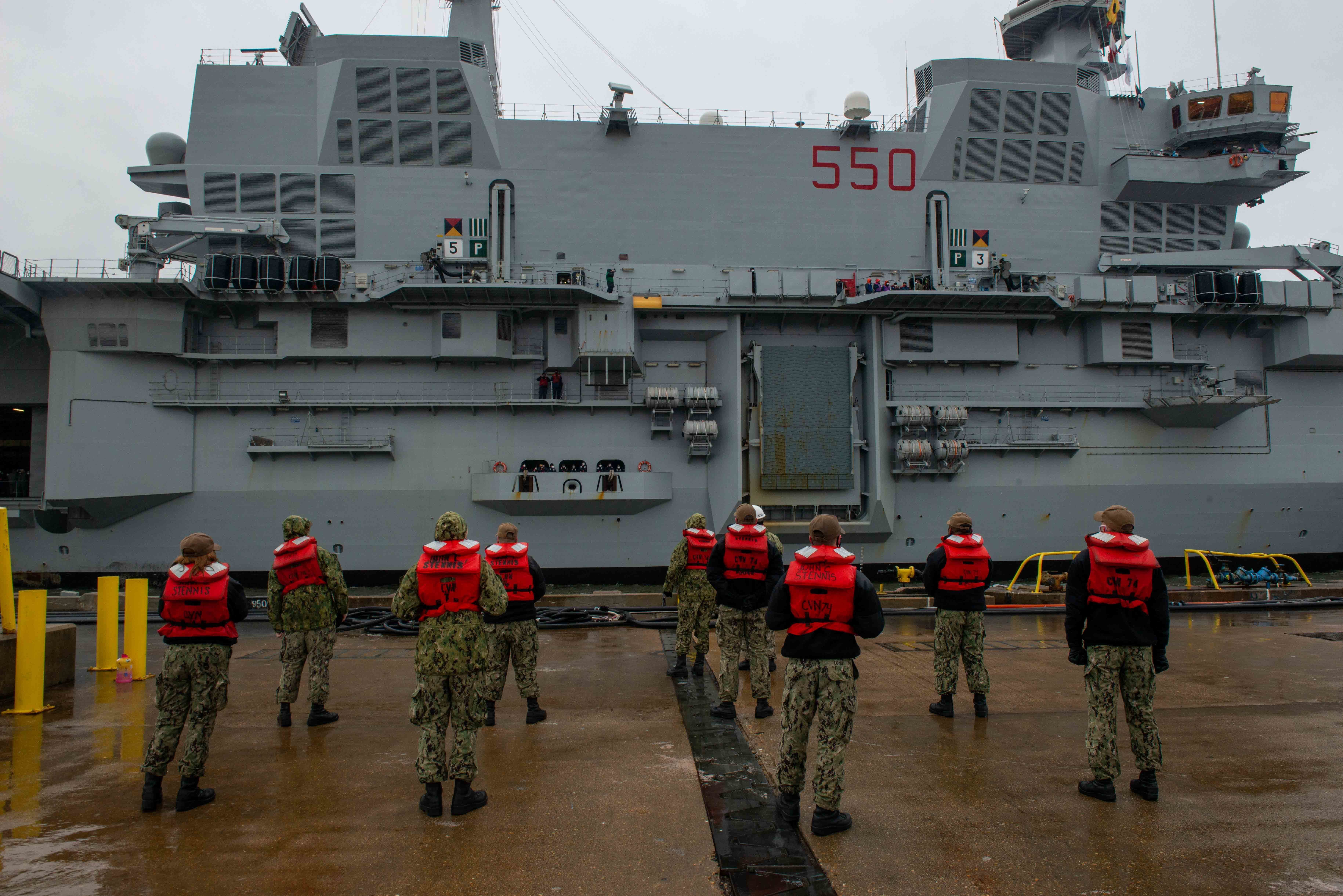
“We couldn’t be more excited to host our Italian ally,” said Captain Cassidy Norman, commanding officer of the Stennis. “The Stennis team fully understands the importance of building trust and cooperation by supporting Cavour’s certification with the newest multirole combat aircraft, the F-35. We are happy to see our Italian naval aviation counterparts dramatically increase their operational capability, strengthening our collective capability.”
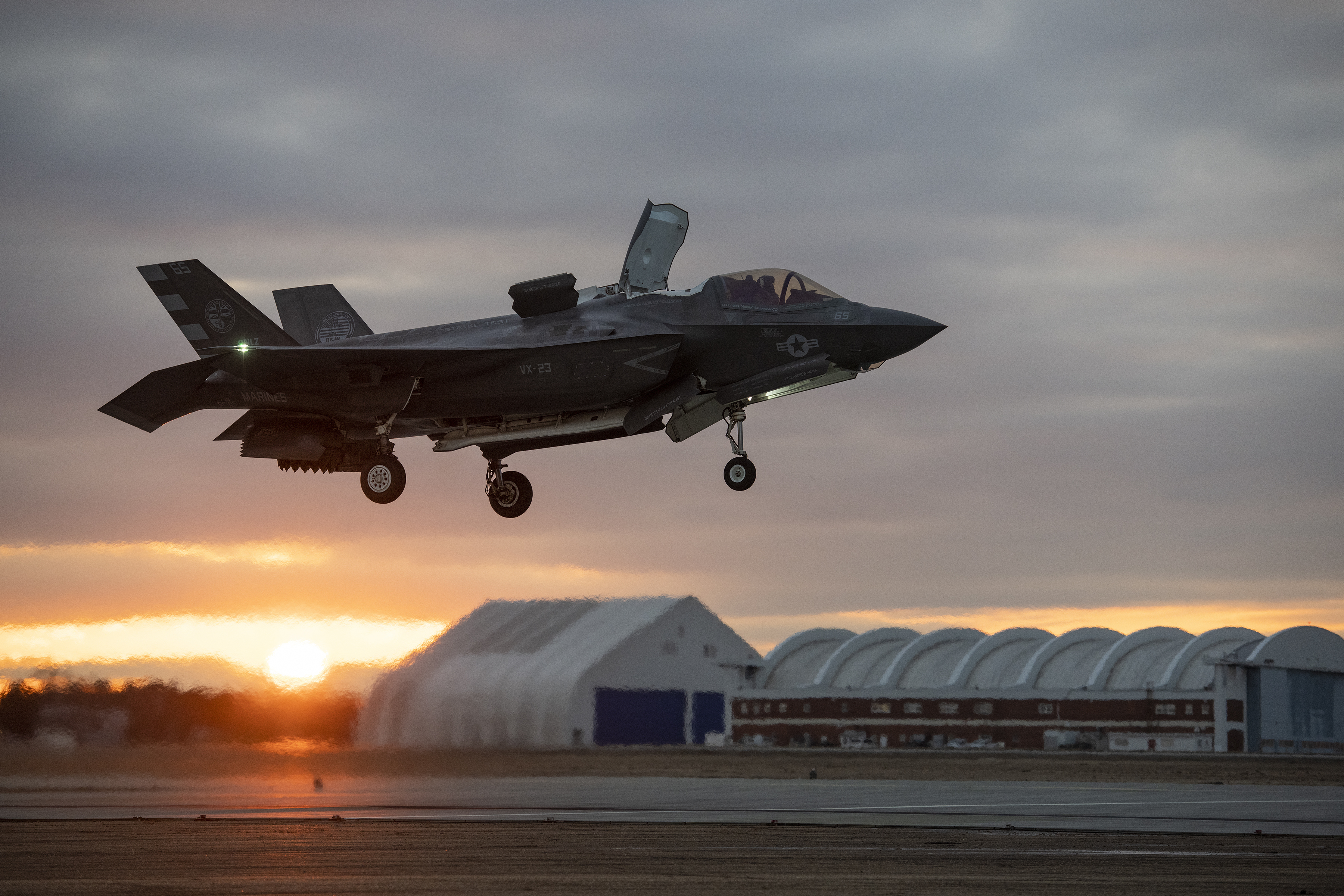
The F-35B trials aboard the Cavour will involve test pilots and flight-test engineers from the ITF at Patuxent River and two specially instrumented developmental flight test aircraft will be embarked on the ship. This suggests that the Italian Navy will not be using any of its own F-35Bs in the trials. The first two Italian Navy F-35Bs, also known as BL-1 and BL-2, both of which were manufactured on the Italian assembly line at Cameri, are currently at Marine Corps Air Station Beaufort, South Carolina, for crew training.
“We are excited to get underway with the sailors of Cavour and honored to contribute to the aircraft carrier achieving the Italian Navy’s strategic goal of it being ‘Ready for Operations,’” said Andrew Maack, F-35 Pax River ITF chief test engineer, and site director. “We look forward to a phenomenally successful shipboard detachment.”
Proving out the F-35B for service aboard the Cavour is a fundamental part of an overhaul of the Italian Navy’s carrier capabilities. The carrier itself has been in service since 2009 and was ordered as a much more capable successor to the Giuseppe Garibaldi, which was introduced in 1985 as a “helicopter cruiser.” It was subsequently redesignated as an “aircraft-carrying cruiser” in 1989 and AV-8B Harrier IIs were added to its air wing.
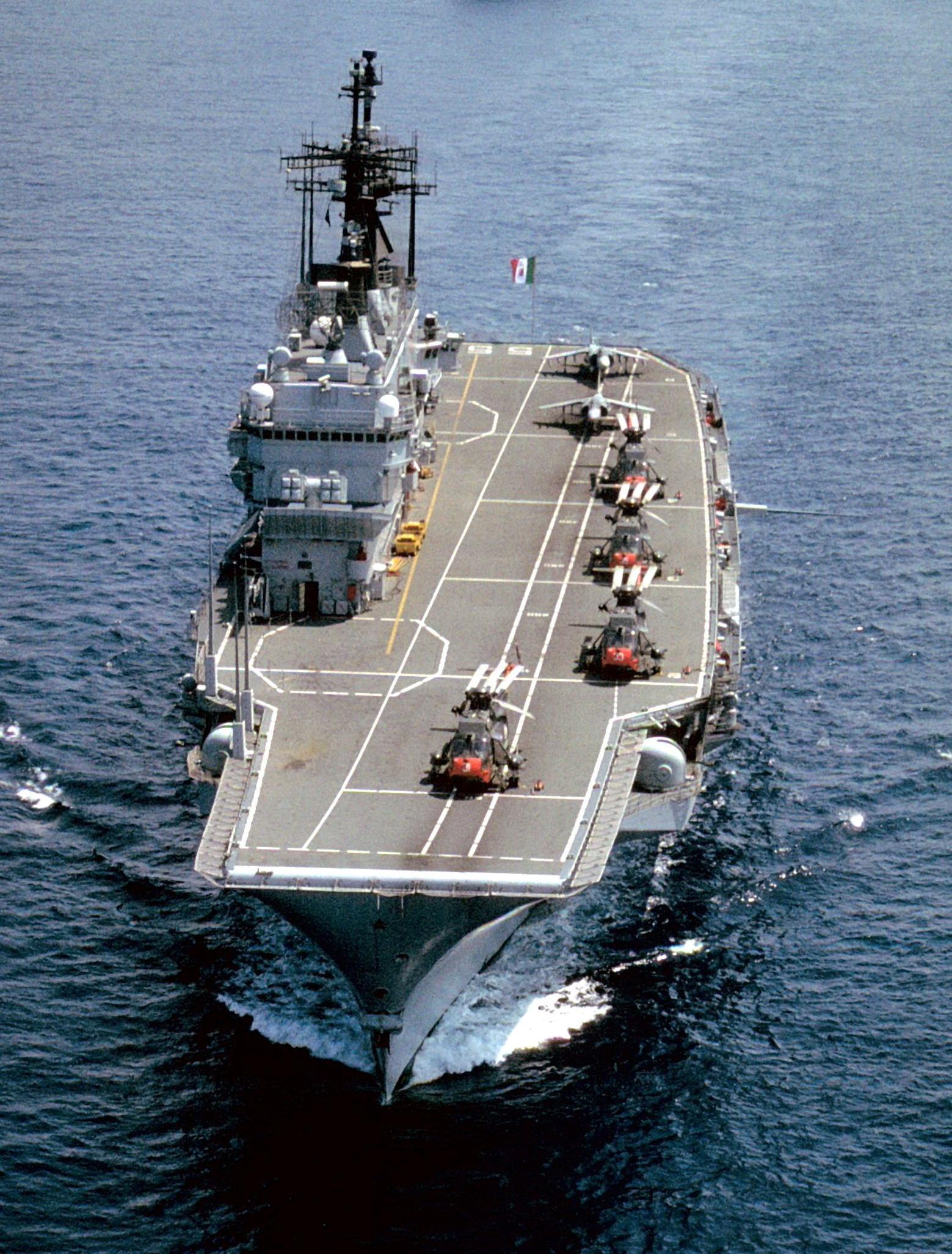
In contrast to its predecessor, the Cavour was intended to embark fixed-wing aircraft from the outset, with these initially being the Italian Navy’s upgraded AV-8B+ jets. After Cavour became the Italian Navy’s new flagship in 2011, Giuseppe Garibaldi was reassigned for amphibious operations, with expanded command and control facilities.
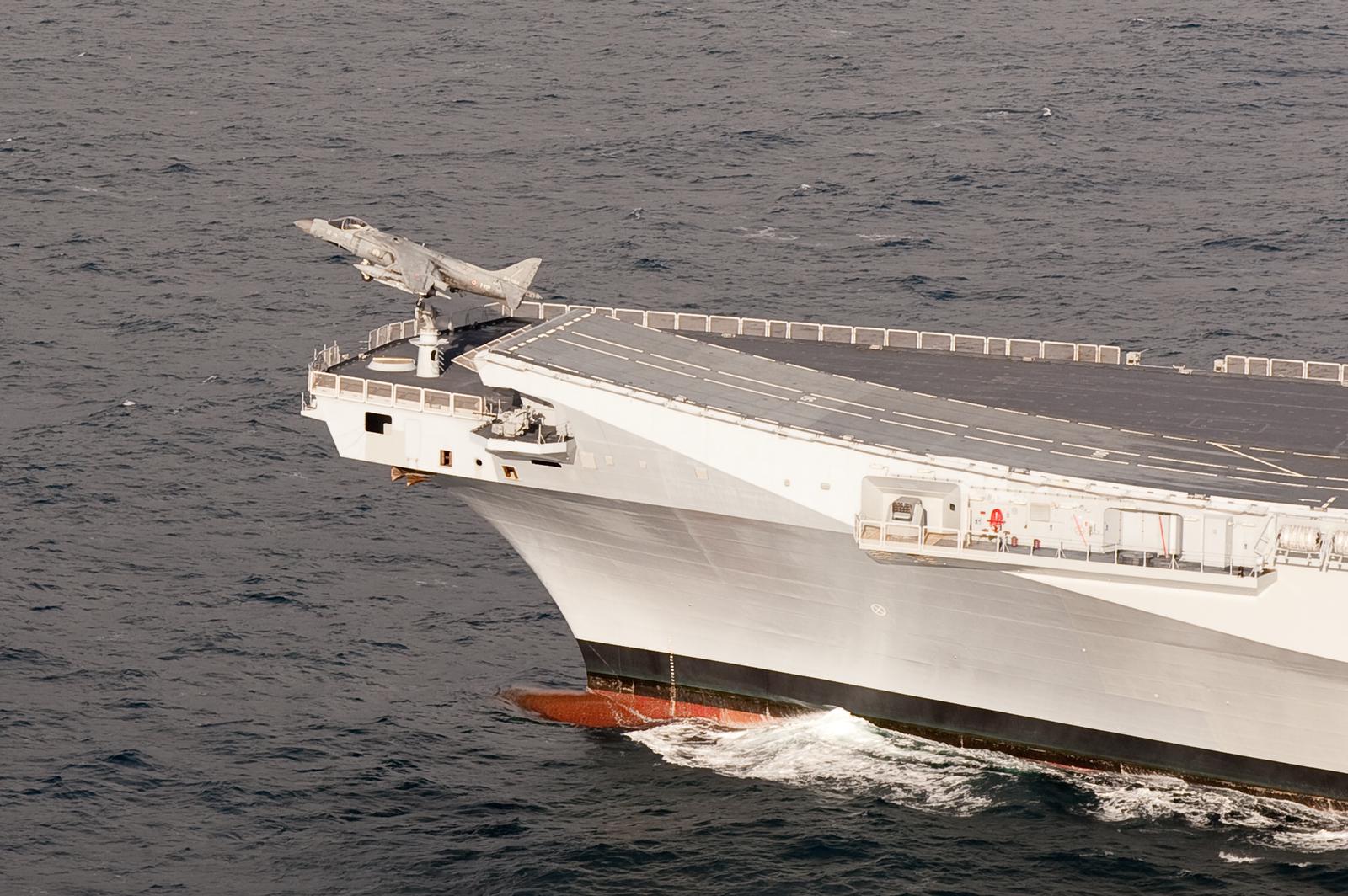
Cavour’s displacement of 26,700 long tons is almost three times greater than Giuseppe Garibaldi and it normally embarks a crew of around 1,200, of which approximately 200 are assigned to the air group.
The Cavour’s 720-foot flight deck has a “ski jump” takeoff ramp angled at 12 degrees and the carrier can accommodate a maximum of 36 aircraft, normally a mix of AV-8B+ jets and AW101 or NH90 helicopters; 24 aircraft can be parked on deck at any one time and 12 can be stowed in the hangar below the deck. Italian Army rotary-wing assets, including the Mangusta attack helicopter and the CH-47 Chinook heavy-lift transport, can also be embarked if required. A total air wing of between 20 and 22 fixed-wing aircraft and helicopters is typically embarked. In due course, the Harriers will be replaced by F-35Bs, 30 of which are on order, to be divided equally between the Italian Navy and the Italian Air Force.
Compared to the Harriers, the F-35B will offer significantly greater overall fixed-wing strike capability and present a future in which the Italian Navy could have a much greater role to play in NATO maritime operations. It also opens up the possibility of closer cooperation between the Italian Navy and the U.S. Marine Corps, perhaps mirroring the situation with the Royal Navy, where a Marine Corps F-35B squadron will be embedded in the air wing during the first operational cruise for the HMS Queen Elizabeth.
The propulsion system is of the combined gas turbine and gas turbine (COGAG) type, with four General Electric/Avio LM-2500 gas turbines producing around 118,000 horsepower connected to a pair of propeller shafts. There are also six Wartsila diesel generators for energy production. The maximum speed is 29 knots, with a maximum range of 7,000 nautical miles at 16 knots. Typical endurance is around 18 days before the warship needs to be refueled.
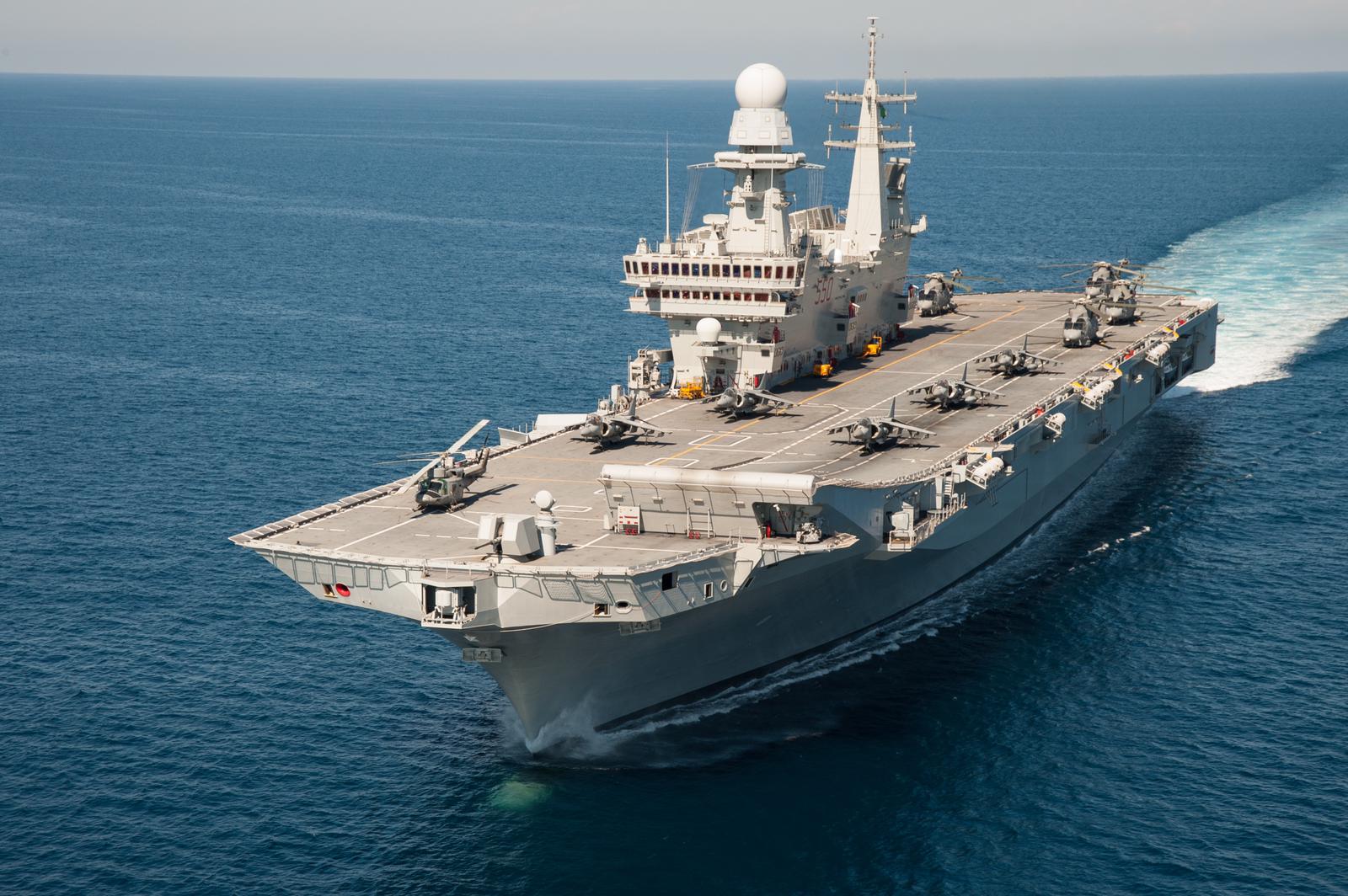
The Cavour is notably well-defended, with four eight-tube Sylver launchers for the MBDA Aster 15 surface-to-air missile providing air defense out to a range of at least 18 miles, a pair of OTO Melara 76mm dual-purpose guns, plus three Oerlikon Contraves 25mm anti-aircraft guns.
As well as being the navy’s flagship, serving as a command post and able to deploy its air wing for offensive and defensive operations, Cavour is designed for use as an amphibious warfare vessel and for a variety of humanitarian missions, being able to embark vehicles and a hospital. In fact, the carrier’s first operational deployment was a humanitarian relief mission, in response to the earthquake that struck Haiti in 2010. A first combat mission took place the following year, during Operation Unified Protector, the NATO intervention in the Libyan Civil War. As a flagship, the Cavour has headed up Operation Sophia, the European Union mission that aimed to neutralize refugee smuggling routes in the Mediterranean.
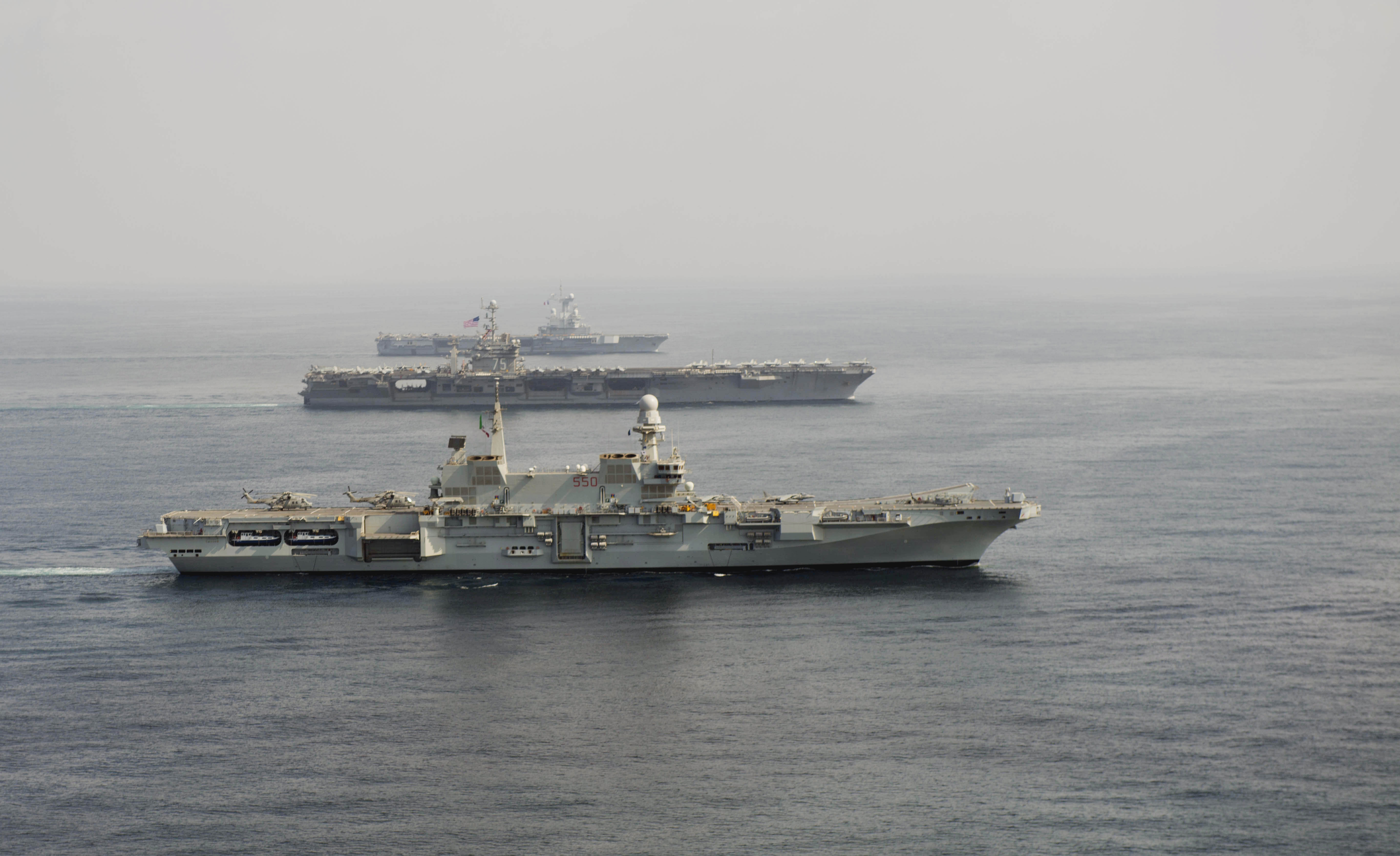
As an amphibious warfare flagship, Cavour can form the centerpiece of a capable task force, together with one or more of the Italian Navy’s amphibious assault ships, the San Giusto, San Giorgio, and San Marco. All three of these can embark and disembark landing craft and vehicles via a bow door and floodable well deck at the stern. These amphibious assault ships can also accommodate helicopters, but not fixed-wing aircraft.
However, in the future, the F-35Bs will also operate from another fixed-wing-capable Italian warship, the Trieste. This is a landing helicopter dock that will replace the Giuseppe Garibaldi and is expected to enter service next year. With a fully loaded displacement of 32,000 long tons, the new warship will be bigger than the Cavour and will combine facilities for fixed-wing and rotary-wing aviation with more comprehensive amphibious capabilities: a floodable well-deck, landing craft including LCAC types, and the ability to carry Ariete main battle tanks, Centauro tank destroyers, and up to 600 soldiers.
Clearly, the F-35B will be a significant capability for both the Cavour and Trieste, but Italy’s procurement of the STOVL version of the Joint Strike Fighter has not been without controversy.
At one stage, the Italian Navy expected to acquire 22 of the STOVL jet fighters, before this was trimmed to 15 in a 2012 spending review. Of these, three will remain in the United States for training, while the other 12 will be based in Italy, co-located with the Italian Air Force’s own fleet of 15 F-35Bs, expected to result in significant savings in terms of training, maintenance, and logistics. The basing decision has not yet been made, but a likely option is Amendola Air Base, home of the Italian Air Force’s first F-35A wing. All the Italian F-35Bs will be assembled locally at Cameri.
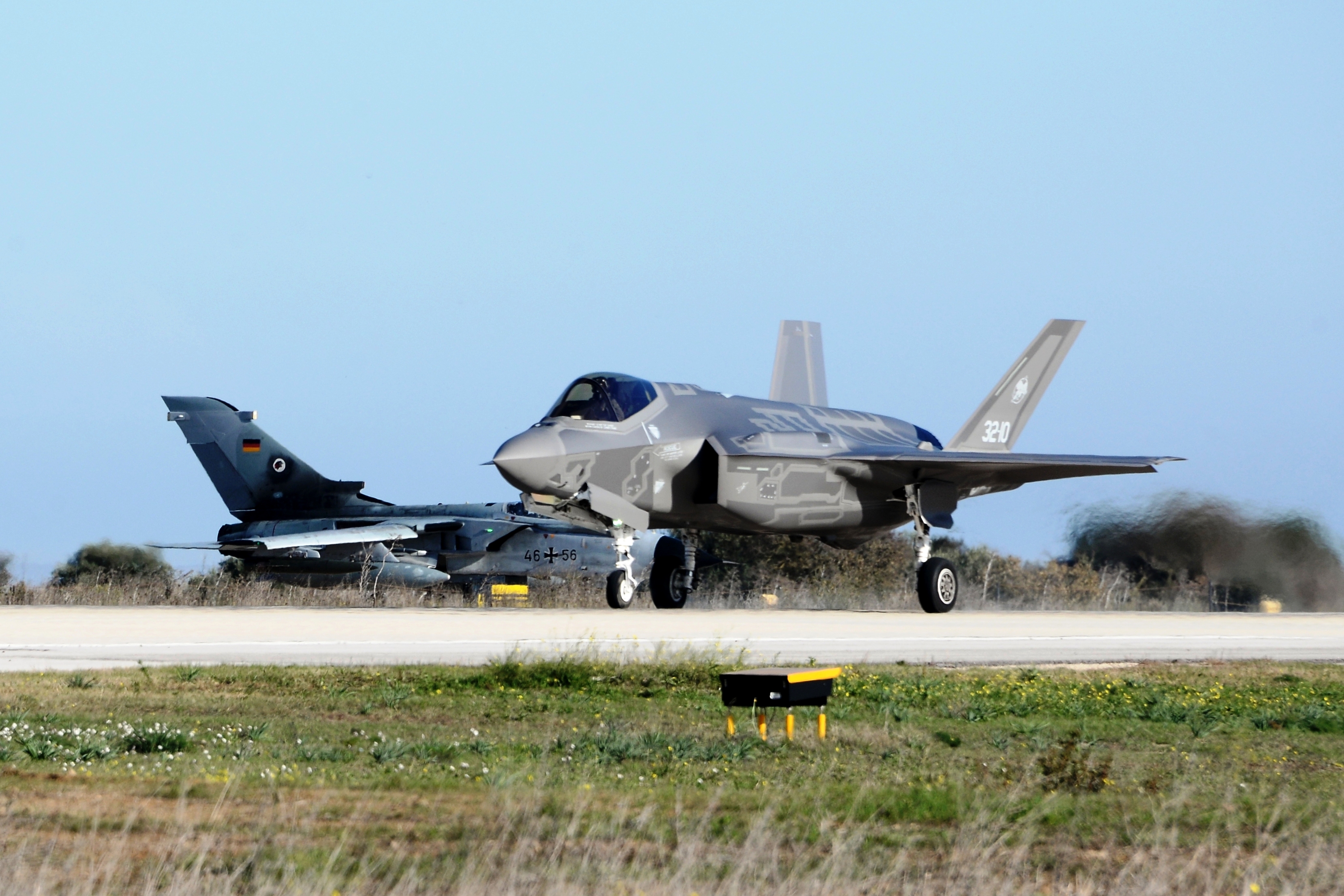
Plans call for Italy’s F-35B to achieve initial operational capability by 2023, leading to a phased withdrawal of the Harriers by 2024-25.
Meanwhile, the third Italian F-35B was delivered to the Italian Air Force early last year and the service has its own plans to use the STOVL version for land-based operations, in addition to the 60 F-35As it plans to procure. In particular, the air force is eyeing the F-35B’s suitability for the kinds of expeditionary missions that the U.S. Marine Corps has been busy pioneering, using both F-35Bs and F-35Cs.
Co-location of the Italian F-35B fleet threatens to result in cuts to the navy’s infrastructure. Should Amendola be chosen as the joint operating location, it would likely lead to the closure of the Italian Navy’s Grottaglie Air Base. This is located somewhat closer to the port of Taranto, which will eventually be home to the Cavour and Trieste. Today, Grottaglie is home to the Harriers and a single helicopter squadron, but with two other rotary-wing bases also active, that unit could likely be relocated in the future.
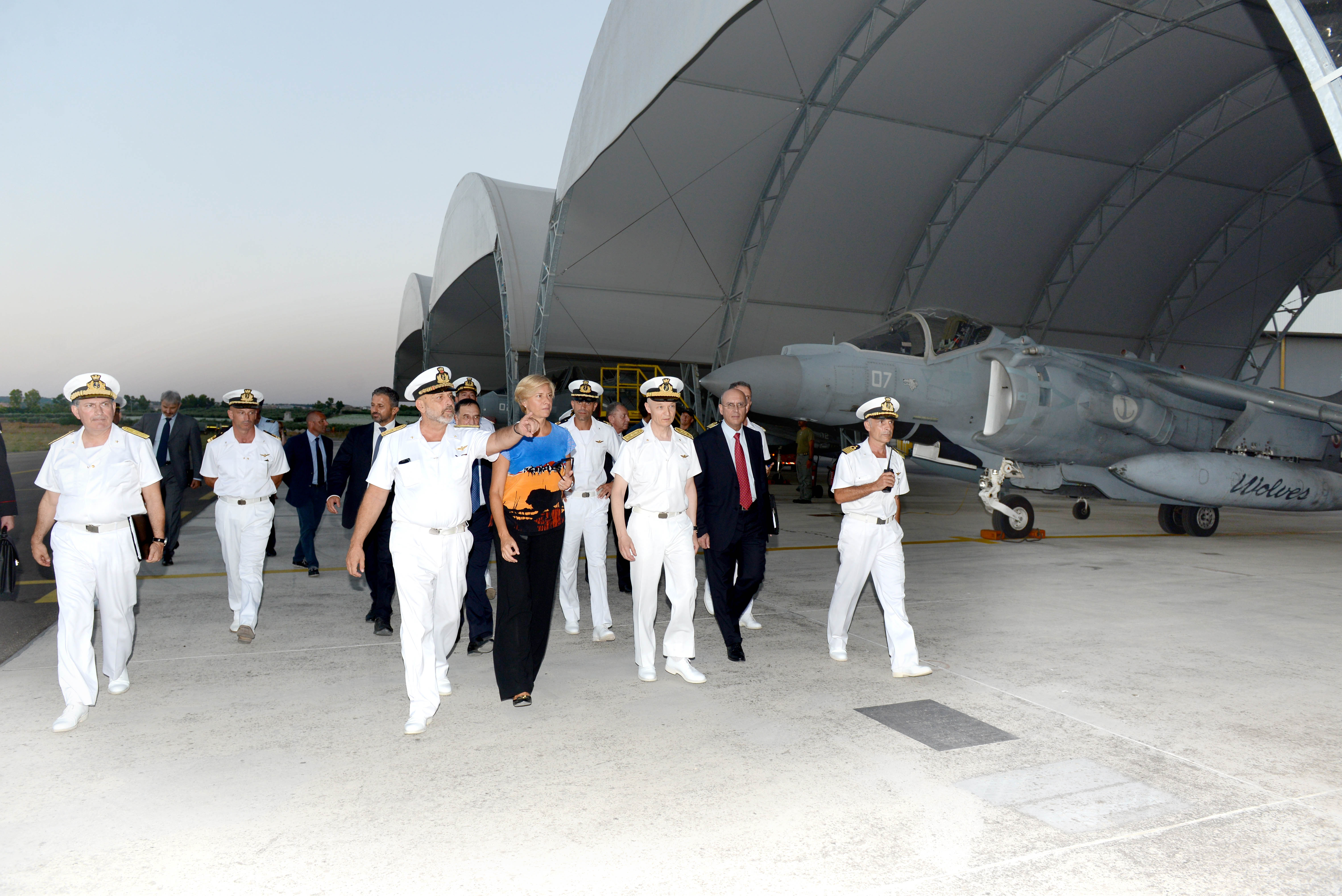
While a similar model is being pursued with the British F-35B fleet, with both Royal Air Force and Royal Navy squadrons to be based at RAF Marham, there is a concern in Italy that it could lead to the air force taking the lead in Joint Strike Fighter operations, to the potential detriment of carrier-based aviation.
Some within the Italian Navy, as well as at least one former admiral, had made calls for the entire F-35B fleet to be transferred to their control. With just 12 jets potentially available to the Italian Navy in-country at any one time, they argue, it will be difficult to generate enough available airframes to support a meaningful carrier deployment. That is, of course, unless the air force provides its own aircraft for such missions, as is planned for the British F-35B fleet.
Regardless of how many Italian F-35Bs are eventually made available to its expanding carrier force, and which service they are operated by, the latest developments confirm the fighter’s importance to the country’s maritime ambitions. As the Italian Ambassador to the United States, Armando Varricchio, observed, the arrival of the carrier in Norfolk also “symbolizes the strong relationship between Italy and the United States and our transatlantic bond, which is imperative for the security of both nations and peace-making at large.”
Contact the author: thomas@thedrive.com
